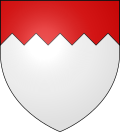
In heraldic blazon, a chief is a charge on a coat of arms that takes the form of a band running horizontally across the top edge of the shield. Writers disagree in how much of the shield's surface is to be covered by the chief, ranging from one-fourth to one-third. The former is more likely if the chief is uncharged, that is, if it does not have other objects placed on it. If charged, the chief is typically wider to allow room for the objects drawn there.
Contents
The chief is one of the ordinaries in heraldry, along with the bend, chevron, fess, and pale. There are several other ordinaries and sub-ordinaries.











